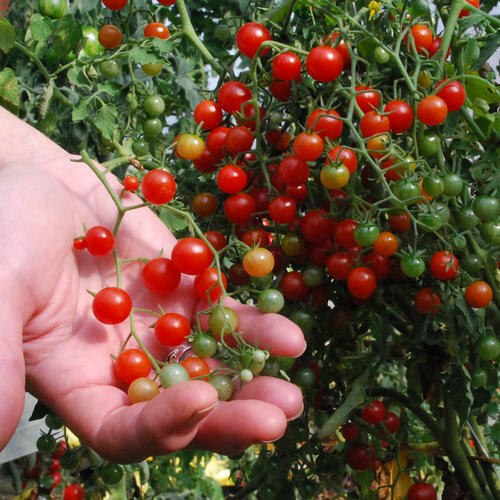HOW TO GROW TOMATO SEEDS

1. Best Sowing Time
Start indoors mid-March to early April with bottom heat. Then grow seedlings on for 6-8 weeks at around 10°C (50°F). Early season tomatoes can be planted out when night time temperatures are reliably above 7°C (45°F). Other types should be transplanted out when night time lows are 10°C (50°F) or warmer. Days to maturity are from transplant date..
2. Soil Temprature:
Optimal soil temperature for germination: 25-35°C (68-95°F). With bottom heat seeds should germinate in 7-14 days.
3. Sowing Method::
Sow seeds 5mm-1cm (¼-½”) deep. Keep seedlings under very bright light to prevent legginess. You may have to pot on seedlings more than once before they go out to allow for root growth. Space bush (determinate) transplants 45-60cm (18-24?) apart and vine (indeterminate) types 50-75cm (20-30?) apart in rows 1m (3?) apart.
4. Growing:
Tomatoes like fertile, well drained soil that is high in organic matter. Dig in finished compost and manure, and add 1 cup complete organic fertilizer beneath each transplant. The nutrition from heavy clay soils is excellent for tomatoes, but they are slow to warm, so transplanting should be done later. By the same token, lighter soils warm more quickly, so transplants can go out sooner. Adding glacial rock dust will supply all the calcium they will need. Regular watering is vital, but don’t let the plants sit in water. Tomatoes are tropical plants so they require full sun and lots of heat. Vine varieties will require some kind of support such as a wire to grow up, or a trellis to be tied to as the plant grows. Bush types benefit from the support of a tomato cage in order to prevent sprawling. At the time of final transplant, plants can be buried up to their first pair of true leaves. This will encourage greater root growth, helping with both nutrient uptake and the plants’ ability to stand up to dry conditions. Stop watering around the end of July to encourage the fruit to ripen. If your plants are grown under cover, you can encourage pollination and fruit set by tapping the stem from time to time. Tomatoes do not rely on insects for pollination. Vibrating the plant shakes pollen loose within the flowers, which then self-pollinate. Indeterminate tomatoes continue to grow and produce fruit until they are killed by frost. Remove any suckers (stems growing from the crotch of leaves) to keep the foliage under control, and they will set a later crop of larger fruit. Determinate varieties normally set fruit in a concentrated time period. Their suckers are not normally removed, though some trimming helps with ventilation.
5. Harvest
Harvest when the fruit is the desired colour. Green tomatoes can be ripened indoors at a cool temperature when they are blemish free. Very dark green tomatoes are unlikely to ripen fully..
6. Companion Planting
Another sensitive plant when it comes to companions, tomatoes benefit from asparagus, basil, beans, borage, carrots, celery, chives, collards, cucumber, garlic, lettuce, marigold, mint, nasturtium, onion, parsley, and peppers. Avoid planting alongside Brassicas and dill. Corn will attract tomato pests, and kohlrabi will stunt tomatoes’ growth. Potatoes may spread blight to tomatoes, so keep them apart. Do no plant tomatoes near walnut trees..
Question & Answers
Don't get what you are looking for? Ask Question